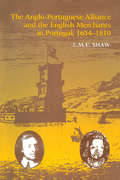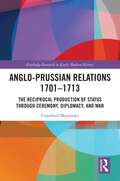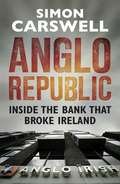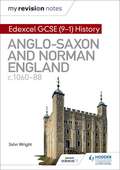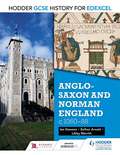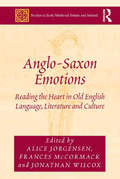- Table View
- List View
The Anglo-Portuguese Alliance and the English Merchants in Portugal 1654–1810
by L.M.E. ShawThe alliance made between Cromwell and John IV in 1654, cemented by the Articles of Marriage between Charles II and Catherine of Braganza in 1661 lasted for 156 years. Together, they provided a guarantee of Portugal’s independence and formed a framework for an expansion of trade between England, Portugal and its overseas possessions. The Inquisition had ruined the ’New Christians’ (Sephardic Jews) who had been Portugal’s principal middlemen, enabling the English merchants to play a dominant role in that expansion once they had overcome their French and Dutch rivals. They held that position until Pombal succeeded by 1770 in breaking the hold which foreigners had established over Portuguese commerce. This book is the result of many years of research into Portuguese and British archival sources. It interweaves politics, economics, religion and commerce to portray what life was like for English merchants in Portugal in the period.
The Anglo-Portuguese Alliance and the English Merchants in Portugal 1654–1810
by L.M.E. ShawThe alliance made between Cromwell and John IV in 1654, cemented by the Articles of Marriage between Charles II and Catherine of Braganza in 1661 lasted for 156 years. Together, they provided a guarantee of Portugal’s independence and formed a framework for an expansion of trade between England, Portugal and its overseas possessions. The Inquisition had ruined the ’New Christians’ (Sephardic Jews) who had been Portugal’s principal middlemen, enabling the English merchants to play a dominant role in that expansion once they had overcome their French and Dutch rivals. They held that position until Pombal succeeded by 1770 in breaking the hold which foreigners had established over Portuguese commerce. This book is the result of many years of research into Portuguese and British archival sources. It interweaves politics, economics, religion and commerce to portray what life was like for English merchants in Portugal in the period.
Anglo-Prussian Relations 1701–1713: The Reciprocal Production of Status through Ceremony, Diplomacy, and War (Routledge Research in Early Modern History)
by Crawford MatthewsIn 1701, Frederick I crowned himself the first King in Prussia. This title required a process of royal status construction in conjunction with other European rulers, and Frederick found his most willing partners in the English monarchy. This volume examines their ceremonial and military cooperation. Diplomatic ceremonial was the medium through which the English state and its representatives recognised the new royal rank of the Hohenzollern dynasty. In exchange, Frederick engaged in extensive military cooperation with the English in the War of the Spanish Succession. Yet English statesmen and diplomats also instrumentalised Anglo-Prussian relations for their own status production, furthering their careers and elevating their rank via the symbolic construction of Prussian royal dignity. This book investigates this reciprocal construction of status and rank, exploring the aims and actions of actors involved, and assessing the extent to which they succeeded. Consequently, this book represents an actor-centred work of ‘new diplomatic history’ that simultaneously reinterprets the reign of Frederick I and assesses a crucial yet understudied chapter in the rise of Prussia.This book will appeal to scholars and students of early modern diplomatic history, as well as general readers interested in the history of England and Prussia.
Anglo-Prussian Relations 1701–1713: The Reciprocal Production of Status through Ceremony, Diplomacy, and War (Routledge Research in Early Modern History)
by Crawford MatthewsIn 1701, Frederick I crowned himself the first King in Prussia. This title required a process of royal status construction in conjunction with other European rulers, and Frederick found his most willing partners in the English monarchy. This volume examines their ceremonial and military cooperation. Diplomatic ceremonial was the medium through which the English state and its representatives recognised the new royal rank of the Hohenzollern dynasty. In exchange, Frederick engaged in extensive military cooperation with the English in the War of the Spanish Succession. Yet English statesmen and diplomats also instrumentalised Anglo-Prussian relations for their own status production, furthering their careers and elevating their rank via the symbolic construction of Prussian royal dignity. This book investigates this reciprocal construction of status and rank, exploring the aims and actions of actors involved, and assessing the extent to which they succeeded. Consequently, this book represents an actor-centred work of ‘new diplomatic history’ that simultaneously reinterprets the reign of Frederick I and assesses a crucial yet understudied chapter in the rise of Prussia.This book will appeal to scholars and students of early modern diplomatic history, as well as general readers interested in the history of England and Prussia.
Anglo Republic: Inside the bank that broke Ireland
by Simon CarswellAs late as 2007, Anglo Irish Bank was a darling of the markets, internationally recognized as one of the fastest growing financial institutions in the world. By 2008, it was bust. The Irish government's hopeless attempts to save Anglo have led the state to ruin - culminating in a punitive IMF bailout in late 2010 and threatening the future of the euro.Now, for the first time, the full story of the Anglo disaster is being told - by the journalist who has led the way in coverage of the bank and its many secrets. Drawing on his unmatched sources in and around Anglo, Simon Carswell of the Irish Times shows how the business model that brought Anglo twenty years of spectacular growth was also at the heart of its - and Ireland's - downfall. He paints a vivid and disturbing picture of life inside Anglo - the credit committee meetings, the lightning-quick negotiations with property developers, the culture of lavish entertainment for politicians and regulators - and of the men who presided over its dizzying rise and fall: Sean FitzPatrick, David Drumm, Willie McAteer and many others. This is not only the first full account of the Anglo disaster; it will also be the definitive one.
Anglo-Russian Rivalry in Central Asia 1810-1895
by Gerald MorganPublished in 1981, Anglo-Russian Rivalry in Central Asia 1810-1895 is a valuable contribution to the field of Middle Eastern Studies.
Anglo-Russian Rivalry in Central Asia 1810-1895
by Gerald MorganPublished in 1981, Anglo-Russian Rivalry in Central Asia 1810-1895 is a valuable contribution to the field of Middle Eastern Studies.
The Anglo-Saxon Age c.400-1042
by D. J. FisherAn introductory survey which provides a clear and accessible account of the centuries between the arrival of the Anglo-Saxons and the Norman Conquest.
The Anglo-Saxon Age c.400-1042
by D. J. FisherAn introductory survey which provides a clear and accessible account of the centuries between the arrival of the Anglo-Saxons and the Norman Conquest.
Anglo-saxon And Norman England, C.1060-88 (My Revision Notes Edexcel GCSE (9-1) History) (PDF)
by John WrightExam Board: Edexcel Level: GCSE Subject: History First Teaching: September 2016 First Exam: Summer 2018 Endorsed for Edexcel Target success in Edexcel GCSE (9-1) History with this proven formula for effective, structured revision; key content coverage is combined with exam-style questions, revision tasks and practical tips to create a revision guide that students can rely on to review, strengthen and test their knowledge. With My Revision Notes, every student can: - Plan and manage a successful revision programme using the topic-by-topic planner - Enjoy an interactive approach to revision, with clear topic summaries that consolidate knowledge and related activities that put the content into context - Build, practise and enhance exam skills by progressing through activities set at different levels - Improve exam technique through exam-style questions and model answers with commentary from expert authors and teachers - Get exam ready with extra quick quizzes and answers to the activities available online
Anglo-saxon And Norman England, C.1060-88 (PDF)
by Esther Arnott Libby Merritt Ian DawsonEndorsed for Edexcel Help your students achieve their full potential while ensuring pace, enjoyment and motivation with this unique series from the leading History publisher; developed by expert educators who know how to instil deep subject knowledge and an appetite for lifelong learning. - Provides distinct approaches to the different components of the 2016 specification, ensuring that your classroom resources are tailored to learners' changing needs as they progress through the curriculum - Caters for varying learning styles, using an exciting mix of clear narrative, visual stimulus materials and a rich collection of contemporary sources to capture the interest of all students - Helps students maximise their grade potential and develop their exam skills through structured guidance on answering every question type successfully - Blends in-depth coverage of topics with activities and strategies to help students acquire, retain and revise core subject knowledge across the years - Builds on our experience publishing popular GCSE resources to supply you with accurate, authoritative content written by experienced teachers who understand the practical implications of new content and assessment requirements Anglo-Saxon and Norman England, c. 1066-88 covers all three key topics in the specification: 'Anglo-Saxon England and the Norman Conquest, 1060-66'; 'William in power: securing the kingdom, 1066-87'; 'Norman England, 1066-88. '
Anglo-Saxon Art to A.D. 900 (Routledge Library Editions: The Anglo-Saxon World #1)
by T.D. KendrickAnglo-Saxon Art to A.D. 900 (1972) was the first account to be written of art in England in the period of Celtic, Romano-British and Anglo-Saxon styles. Famous illuminated manuscripts, the best of the sculptured stone crosses, and many splendid pieces early metalwork are examined in this extensively-illustrated survey.
Anglo-Saxon Art to A.D. 900 (Routledge Library Editions: The Anglo-Saxon World #1)
by T.D. KendrickAnglo-Saxon Art to A.D. 900 (1972) was the first account to be written of art in England in the period of Celtic, Romano-British and Anglo-Saxon styles. Famous illuminated manuscripts, the best of the sculptured stone crosses, and many splendid pieces early metalwork are examined in this extensively-illustrated survey.
The Anglo-Saxon Chronicle
by James IngramOriginally compiled on the orders of King Alfred the Great, approximately A.D. 890, and subsequently maintained and added to by generations of anonymous scribes until the middle of the 12th Century.
Anglo-Saxon Coins: Studies Presented to F.M. Stenton on the Occasion of his 80th Birthday, 17 May 1960 (Routledge Library Editions: The Anglo-Saxon World #2)
by R. H. M. DolleyAnglo-Saxon Coins (1961) is an illustrated analysis of the coinage of the Anglo-Saxon era. It examines the coins of the end of Roman Britain and those of the Anglo-Saxon kingdoms, as well as those of the Vikings, Ireland and Wales.
Anglo-Saxon Coins: Studies Presented to F.M. Stenton on the Occasion of his 80th Birthday, 17 May 1960 (Routledge Library Editions: The Anglo-Saxon World #2)
Anglo-Saxon Coins (1961) is an illustrated analysis of the coinage of the Anglo-Saxon era. It examines the coins of the end of Roman Britain and those of the Anglo-Saxon kingdoms, as well as those of the Vikings, Ireland and Wales.
Anglo-Saxon Emotions: Reading the Heart in Old English Language, Literature and Culture (Studies in Early Medieval Britain and Ireland)
by Alice Jorgensen Frances McCormack Jonathan WilcoxResearch into the emotions is beginning to gain momentum in Anglo-Saxon studies. In order to integrate early medieval Britain into the wider scholarly research into the history of emotions (a major theme in other fields and a key field in interdisciplinary studies), this volume brings together established scholars, who have already made significant contributions to the study of Anglo-Saxon mental and emotional life, with younger scholars. The volume presents a tight focus - on emotion (rather than psychological life more generally), on Anglo-Saxon England and on language and literature - with contrasting approaches that will open up debate. The volume considers a range of methodologies and theoretical perspectives, examines the interplay of emotion and textuality, explores how emotion is conveyed through gesture, interrogates emotions in religious devotional literature, and considers the place of emotion in heroic culture. Each chapter asks questions about what is culturally distinctive about emotion in Anglo-Saxon England and what interpretative moves have to be made to read emotion in Old English texts, as well as considering how ideas about and representations of emotion might relate to lived experience. Taken together the essays in this collection indicate the current state of the field and preview important work to come. By exploring methodologies and materials for the study of Anglo-Saxon emotions, particularly focusing on Old English language and literature, it will both stimulate further study within the discipline and make a distinctive contribution to the wider interdisciplinary conversation about emotions.
Anglo-Saxon Emotions: Reading the Heart in Old English Language, Literature and Culture (Studies in Early Medieval Britain and Ireland)
by Alice Jorgensen Frances McCormack Jonathan WilcoxResearch into the emotions is beginning to gain momentum in Anglo-Saxon studies. In order to integrate early medieval Britain into the wider scholarly research into the history of emotions (a major theme in other fields and a key field in interdisciplinary studies), this volume brings together established scholars, who have already made significant contributions to the study of Anglo-Saxon mental and emotional life, with younger scholars. The volume presents a tight focus - on emotion (rather than psychological life more generally), on Anglo-Saxon England and on language and literature - with contrasting approaches that will open up debate. The volume considers a range of methodologies and theoretical perspectives, examines the interplay of emotion and textuality, explores how emotion is conveyed through gesture, interrogates emotions in religious devotional literature, and considers the place of emotion in heroic culture. Each chapter asks questions about what is culturally distinctive about emotion in Anglo-Saxon England and what interpretative moves have to be made to read emotion in Old English texts, as well as considering how ideas about and representations of emotion might relate to lived experience. Taken together the essays in this collection indicate the current state of the field and preview important work to come. By exploring methodologies and materials for the study of Anglo-Saxon emotions, particularly focusing on Old English language and literature, it will both stimulate further study within the discipline and make a distinctive contribution to the wider interdisciplinary conversation about emotions.
Anglo-Saxon England (Routledge Library Editions: The Anglo-Saxon World #3)
by Lloyd and LaingAnglo-Saxon England (1979) takes the history and archaeology of Britain from the fifth century AD through to 1066, covering perhaps the most enigmatic period in British history, when post-Roman, native British and Continental influences amalgamated, in a manner often difficult to unravel. Drawing upon archaeology, history, literature, place-names and the results of the latest scientific methods, the authors show how the Anglo-Saxons built up a flourishing civilization, the foundation of English life, and have bequeathed their legacy to the English-speaking people of the New World.
Anglo-Saxon England (Routledge Library Editions: The Anglo-Saxon World #3)
by Lloyd and LaingAnglo-Saxon England (1979) takes the history and archaeology of Britain from the fifth century AD through to 1066, covering perhaps the most enigmatic period in British history, when post-Roman, native British and Continental influences amalgamated, in a manner often difficult to unravel. Drawing upon archaeology, history, literature, place-names and the results of the latest scientific methods, the authors show how the Anglo-Saxons built up a flourishing civilization, the foundation of English life, and have bequeathed their legacy to the English-speaking people of the New World.
Anglo-Saxon England (Oxford History of England #2)
by Sir Frank M. StentonDiscussing the development of English society, from the growth of royal power to the establishment of feudalism after the Norman Conquest, this book focuses on the emergence of the earliest English kingdoms and the Anglo-Norman monarchy in 1087. It also describes the chief phases in the history of the Anglo-Saxon church, drawing on many diverse examples; the result is a fascinating insight into this period of English history.
Anglo-Saxon England (Oxford History of England #2)
by Sir Frank M. StentonDiscussing the development of English society, from the growth of royal power to the establishment of feudalism after the Norman Conquest, this book focuses on the emergence of the earliest English kingdoms and the Anglo-Norman monarchy in 1087. It also describes the chief phases in the history of the Anglo-Saxon church, drawing on many diverse examples; the result is a fascinating insight into this period of English history.
Anglo Saxon England and the Norman Conquest
by H. R. LoynThis celebrated account of society and economy in England from the first Anglo-Saxon settlements in the fifth century to the immediate aftermath of the Norman Conquest has been a standard text since it first appeared in 1962. This long-awaited second edition incorporates the fruits of 30 years of subsequent scholarship. It has been revised expanded and entirely reset.
Anglo Saxon England and the Norman Conquest
by H. R. LoynThis celebrated account of society and economy in England from the first Anglo-Saxon settlements in the fifth century to the immediate aftermath of the Norman Conquest has been a standard text since it first appeared in 1962. This long-awaited second edition incorporates the fruits of 30 years of subsequent scholarship. It has been revised expanded and entirely reset.
Anglo-Saxon Farms and Farming (Medieval History and Archaeology)
by Debby Banham Rosamond FaithFarming was the basis of the wealth that made England worth invading, twice, in the eleventh century, while trade and manufacturing were insignificant by modern standards. In Anglo-Saxon Farms and Farming, the authors employ a wide range of evidence to investigate how Anglo-Saxon farmers produced the food and other agricultural products that sustained English economy, society, and culture before the Norman Conquest. The first part of the volume draws on written and pictorial sources, archaeology, place-names, and the history of the English language to discover what crops and livestock people raised, and what tools and techniques were used to produce them. In part two, using a series of landscape studies - place-names, maps, and the landscape itself, the authors explore how these techniques might have been combined into working agricultural regimes in different parts of the country. A picture emerges of an agriculture that changed from an essentially prehistoric state in the sub-Roman period to what was recognisably the beginning of a tradition that only ended with the Second World War. Anglo-Saxon farming was not only sustainable, but infinitely adaptable to different soils and geology, and to a climate changing as unpredictably as it is today.
